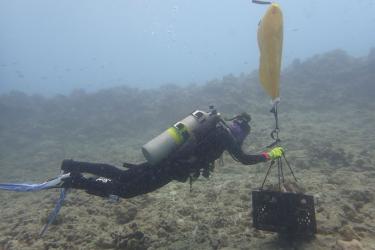Have you ever wanted to participate in exciting research? Do you love watching turtles? Your dream has come true! NOAA Fisheries has launched a new online survey to report sightings of sea turtles with white numbers and letters etched temporarily on their shells.
What is Honu Count?
Honu Count is a citizen science project that started in 2017. It’s a way for the public to engage in sea turtle research and conservation by reporting turtles they see with shell etchings around Hawai‘i. Previously, sightings were reported through phone calls or emails. This new online system makes it easier to report sightings and helps researchers more accurately track honu locations. The Honu Count survey can even be accessed through your smartphone, allowing anyone to report in real time. A map is generated on the survey, allowing the user to place a pin of the sighting, giving researchers exact coordinates of the turtle’s location.
Why is Honu Count important?
Sea turtles have internal compasses that use the earth’s geomagnetic signposts to help them navigate back to the beaches where they were hatched, to reproduce. Most mature honu that live around the main Hawaiian Islands travel northwest during the spring to reproduce at Lalo, or French Frigate Shoals. That’s an atoll in the Papahānaumokuākea Marine National Monument. This round-trip migration begins at their foraging habitats around the main Hawaiian Islands and extends more than 500 miles to Lalo. This public science opportunity provides NOAA Fisheries with valuable data on locations where sea turtles eat and live. This allows scientists to
- Track population abundance
- Monitor the recovery of rehabilitated turtles
- Understand migration destinations of nesting honu returning to marine habitats of the main Hawaiian Islands
How do I report a honu sighting safely?
Visit our Honu Count page to learn tips for safe viewing and reporting. NOAA Fisheries encourages the public in Hawai‘i to observe turtles from a responsible distance of at least 10 feet, even when attempting to get a photo of shell etchings for reporting purposes. If you spot an injured or a dead animal, call NOAA’s Marine Wildlife Hotline: (888) 256-9840.





